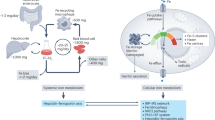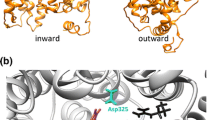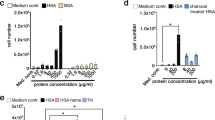Abstract
Iron is an essential component of many biological processes. However, an excess of iron in the body is also toxic; thus, the levels of this element are tightly regulated. Our knowledge of the mechanism by which iron levels are maintained has been bolstered by the dramatic increase in the discovery of novel molecules implicated in iron homeostasis. The transferrin receptor-transferrin pathway is the main mechanism by which cells take up iron. The recently identified homolog of transferrin receptor, its characterization and its role in iron metabolism is the subject of this review.
Similar content being viewed by others
References
Ponka, P. and Lok, C. N. (1999) The transferrin receptor: role in health and disease. Int. J. Biochem. Cell Biol. 31, 1111–1137.
Leibman, A. and Aisen, P. (1977) Transferrin receptor of the rabbit reticulocyte. Biochemistry 16, 1268–1272.
McClelland, A., Kuhn, L. C., and Ruddle, F. H. (1984) The human transferrin receptor gene: genomic organization, and the complete primary structure of the receptor deduced from a cDNA sequence. Cell 39, 267–274.
Kuhn, L. C., McClelland, A., and Ruddle, F. H. (1984) Gene transfer, expression, and molecular cloning of the human transferrin receptor gene. Cell 37, 95–103.
Glockner, G., Scherer, S., Schattevoy, R., Boright, A., Weber, J., Tsui, L. C., et al. (1998) Large-scale sequencing of two regions in human chromosome 7q22: analysis of 650 kb of genomic sequence around the EPO and CUTL1 loci reveals 17 genes. Genome Res. 8, 1060–1073.
Kawabata, H., Yang, R., Hirama, T., Vuong, P. T., Kawano, S., Gombart, A. F., et al. (1999) Molecular cloning of transferrin receptor 2. A new member of the transferrin receptor-like family. J. Biol. Chem. 274, 20,826–20,832.
Fleming, R. E., Migas, M. C., Holden, C. C., Waheed, A., Britton, R. S., Tomatsu, S., et al. (2000) Transferrin receptor 2: continued expression in mouse liver in the face of iron overload and in hereditary hemochromatosis. Proc. Natl. Acad. Sci. USA 97, 2214–2219.
Wilson, M. D., Riemer, C., Martindale, D. W., Schnupf, P., Boright, A. P., Cheung, T. L., et al. (2001) Comparative analysis of the gene-dense ACHE/TFR2 region on human chromosome 7q22 with the orthologous region on mouse chromosome 5. Nucleic Acids Res. 29, 1352–1365.
Collawn, J. F., Stangel, M., Kuhn, L. A., Esekogwu, V., Jing, S. Q., Trowbridge, I. S., et al. (1990) Transferrin receptor internalization sequence YXRF implicates a tight turn as the structural recognition motif for endocytosis. Cell 63, 1061–1072.
Jing, S. Q., Spencer, T., Miller, K., Hopkins, C., and Trowbridge, I. S. (1990) Role of the human transferrin receptor cytoplasmic domain in endocytosis: localization of a specific signal sequence for internalization. J. Cell Biol. 110, 283–294.
Dubljevic, V., Sali, A., and Goding, J. W. (1999) A conserved RGD (Arg-GlyAsp) motif in the transferrin receptor is required for binding to transferrin. Biochem. J. 341, 11–14.
Luo, X. and Hofmann, K. (2001) The protease-associated domain: a homology domain associated with multiple classes of proteases. Trends Biochem. Sci. 26, 147–148.
Mahon, P. and Bateman, A. (2000) The PA domain: a protease-associated domain. Protein Sci. 9, 1930–1934.
Kawabata, H., Nakamaki, T., Ikonomi, P., Smith, R. D., Germain, R. S., and Koeffler, H. P. (2001) Expression of transferrin receptor 2 in normal and neoplastic hematopoietic cells. Blood 98, 2714–2719.
Enns, C. A. (2001) Pumping iron: the strange partnership of the hemochromatosis protein, a class I MHC homolog, with the transferrin receptor. Traffic 2, 167–174.
Camaschella, C., Roetto, A., Cali, A., De Gobbi, M., Garozzo, G., Carella, M., et al. (2000) The gene TFR2 is mutated in a new type of haemochromatosis mapping to 7q22. Nature Genet. 25, 14–15.
Roetto, A., Totaro, A., Piperno, A., Piga, A., Longo, F., Garozzo, G., et al. (2001) New mutations inactivating transferrin receptor 2 in hemochromatosis type 3. Blood 97, 2555–2560.
Piperno, A., Sampietro, M., Pietrangelo, A., Arosio, C., Lupica, L., Montosi, G., et al., (1998) Heterogeneity of hemochromatosis in Italy. Gastroenterology 114, 996–1002.
Aguilar-Martinez, P., Esculie-Coste, C., Bismuth, M., Giansily-Blaizot, M., Larrey, D., and Schved, J. F. (2001) Transferrin receptor-2 gene and non-C282Y homozygous patients with hemochromatosis. Blood Cells Mol. Dis. 27, 290–293.
Barton, E. H., West, P. A., Rivers, C. A., Barton, J. C., and Acton, R. T. (2001) Transferrin receptor-2 (TFR2) mutation Y250X in Alabama Caucasian and African American subjects with and without primary iron overload. Blood Cells Mol. Dis. 27, 279–284.
Lee, P. L., Halloran, C., West, C., and Beutler, E. (2001) Mutation analysis of the transferrin receptor-2 gene in patients with iron overload. Blood Cells Mol. Dis. 27, 285–289.
Griffiths, W. J. H. and Cox, T. M. (2001) Transferrin receptor 2 interacts with HFE and is implicated in crypt cell iron signalling. Proceedings of Bioiron 2001. World Congress on Iron Metabolism, Cairns, Australia 2001, abstract O 11.
West, A. P., Jr., Bennett, M. J., Sellers, V. M., Andrews, N. C., Enns, C. A. and Bjorkman, P. J. (2000) Comparison of the interactions of transferrin receptor and transferrin receptor 2 with transferrin and the hereditary hemochromatosis protein HFE. J. Biol. Chem. 275, 38,135–38,138.
Summerville, L. and Subramaniam, V. N. (2001) Molecular characterisation of transferrin receptor 2. Proceedings of Bioiron 2001. World Congress on Iron Metabolism, Cairns, Australia 2001, abstract, p. 192.
Nicolas, G., Bennoun, M., Devaux, I., Beaumont, C., Grandchamp, B., Kahn, A., et al. (2001) Lack of hepcidin gene expression and severe tissue iron overload in upstream stimulatory factor 2 (USF2) knockout mice. Proc. Natl. Acad. Sci. USA 98, 8780–8785.
Park, C. H., Valore, E. V., Waring, A. J., and Ganz, T. (2001) Hepcidin, a urinary antimicrobial peptide synthesized in the liver. J. Biol. Chem. 276, 7806–7810.
Pigeon, C., Ilyin, G., Courselaud, B., Leroyer, P., Turlin, B., Brissot, P., et al. (2001) A new mouse liver-specific gene, encoding a protein homologous to human antimicrobial peptide hepcidin, is overexpressed during iron overload. J. Biol. Chem. 276, 7811–7819.
Levy, J. E., Jin, O., Fujiwara, Y., Kuo, F., and Andrews, N. C. (1999) Transferrin receptor is necessary for development of erythrocytes and the nervous system. Nature Genet. 21, 396–399.
Author information
Authors and Affiliations
Corresponding author
Rights and permissions
About this article
Cite this article
Subramaniam, V.N., Summerville, L. & Wallace, D.F. Molecular and cellular characterization of transferrin receptor 2. Cell Biochem Biophys 36, 235–239 (2002). https://doi.org/10.1385/CBB:36:2-3:235
Issue Date:
DOI: https://doi.org/10.1385/CBB:36:2-3:235




